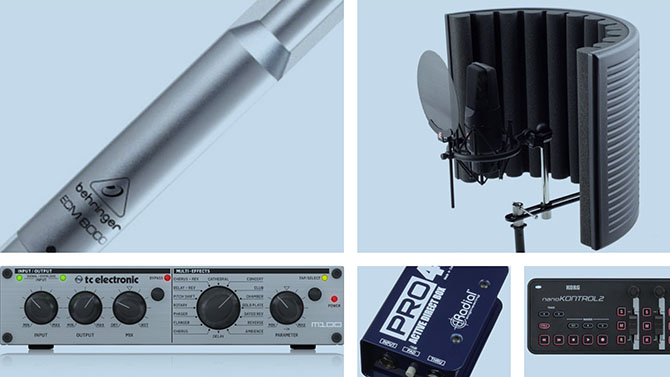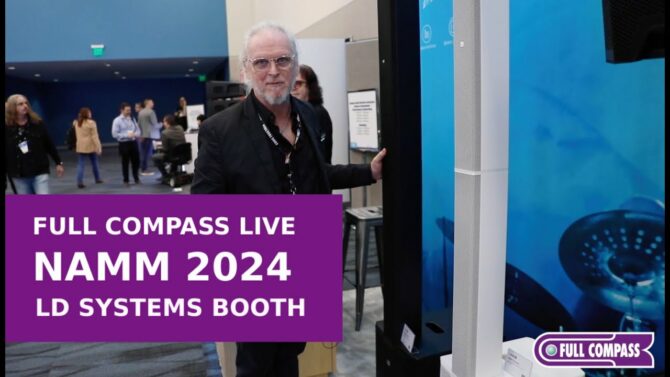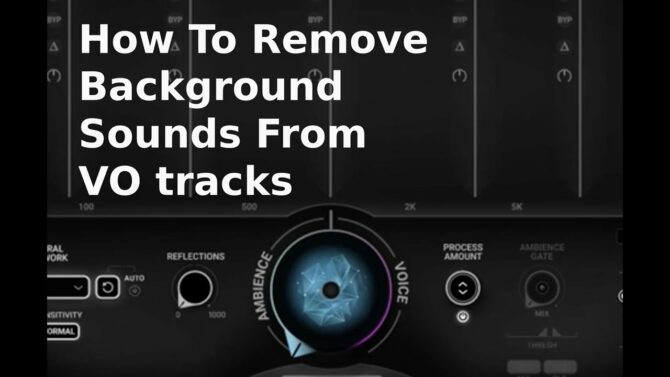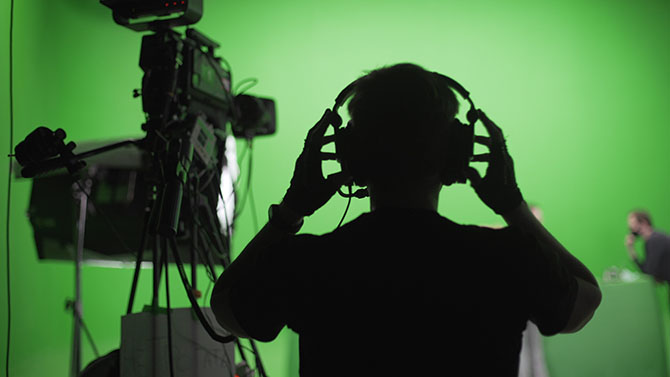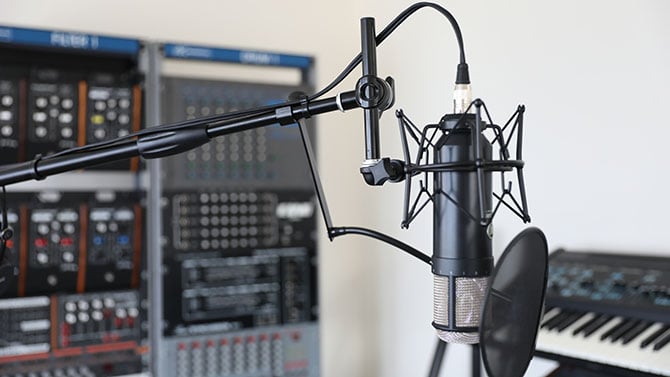The bad news: with fall approaching, colder temperatures will be upon us soon. The great news: being inside means spending more time in the studio, whether for commercial projects, education, or our own enjoyment. So let’s make our lives easier, and more productive, with a bunch of inexpensive—and very useful—studio accessories.
Take the Most Direct Route
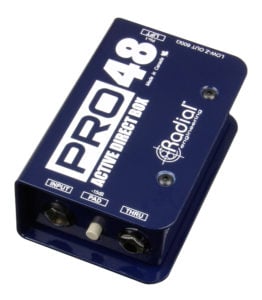
There’s no shortage of direct boxes: active Definition:
Definition:
See: Active Circuit., passive Definition:
Definition:
An electrical device or circuit whose parts require no power (e.g., there are no transistors or tubes)., transformer Definition: A passive electromagnetic device that uses one or more coils of wire to isolate or split signals. Also may convert impedance and voltage levels. May be used to eliminate ground loops, reduce Rf interference or crosstalk., no transformer. But Radial Engineering’s Pro48 (Fig. 1) has some standout features it’s a phantom-powered, active direct box
Definition: A passive electromagnetic device that uses one or more coils of wire to isolate or split signals. Also may convert impedance and voltage levels. May be used to eliminate ground loops, reduce Rf interference or crosstalk., no transformer. But Radial Engineering’s Pro48 (Fig. 1) has some standout features it’s a phantom-powered, active direct box Definition: Also called DI or Direct Injection Box. A device that can send a signal from an electronic instrument directly into a mixer, thus substituting for a microphone. that can handle the kind of huge transient
Definition: Also called DI or Direct Injection Box. A device that can send a signal from an electronic instrument directly into a mixer, thus substituting for a microphone. that can handle the kind of huge transient Definition: A fast rising, non-repeating waveform, usually of short duration. peaks associated with acoustic guitar and bass. However, it also has a 220k input impedance
Definition: A fast rising, non-repeating waveform, usually of short duration. peaks associated with acoustic guitar and bass. However, it also has a 220k input impedance Definition: The load an input circuit places on the source; loading can reduce levels or alter frequency response. In modern audio gear, the input impedance is about 10 times higher than the source impedance, called bridging. In traditional, radio frequency, video and long-distance telephone circuits the source and destination impedance are matched (600 ohms in audio, 50 or 75 ohms for RF and video)., making it suitable for electric guitars with passive pickups. Other features are a ground
Definition: The load an input circuit places on the source; loading can reduce levels or alter frequency response. In modern audio gear, the input impedance is about 10 times higher than the source impedance, called bridging. In traditional, radio frequency, video and long-distance telephone circuits the source and destination impedance are matched (600 ohms in audio, 50 or 75 ohms for RF and video)., making it suitable for electric guitars with passive pickups. Other features are a ground Definition: A common zero-volt potential connection, commonly used for both electrical noise control and safety, and usually connected to the ground of the earth through a spike, plumbing, or electrical wiring that leads eventually to an earth connection. AKA: Earth. lift to help minimize hum
Definition: A common zero-volt potential connection, commonly used for both electrical noise control and safety, and usually connected to the ground of the earth through a spike, plumbing, or electrical wiring that leads eventually to an earth connection. AKA: Earth. lift to help minimize hum Definition: An undesired continuous signal caused by AC electrical power, typically 60/50 Hz and its harmonics. issues, -15 dB
Definition: An undesired continuous signal caused by AC electrical power, typically 60/50 Hz and its harmonics. issues, -15 dB Definition: 1. A deciBel is a logarithmic ratio between two quantities, and is a nonlinear measurement that mimics human perception. 2. A unit expressing sound levels relative to a nominal level just audible by the average human ear, and equal to 1/10th of a Bel. 3. (slang) Database. input pad
Definition: 1. A deciBel is a logarithmic ratio between two quantities, and is a nonlinear measurement that mimics human perception. 2. A unit expressing sound levels relative to a nominal level just audible by the average human ear, and equal to 1/10th of a Bel. 3. (slang) Database. input pad Definition: 1. (Passive Attenuation Device) A device that reduces (attenuates) the output of one device so it does not overload the next device in line. Typically either built-in to a condenser microphone after the capsule, a preamp, a mixer channel, or as a stand-alone, in-line accessory. 2. In music, a sustained, usually lush chord that provides a background sound to lead and harmony parts., and a thru jack—ideal for situations like feeding a bass amp
Definition: 1. (Passive Attenuation Device) A device that reduces (attenuates) the output of one device so it does not overload the next device in line. Typically either built-in to a condenser microphone after the capsule, a preamp, a mixer channel, or as a stand-alone, in-line accessory. 2. In music, a sustained, usually lush chord that provides a background sound to lead and harmony parts., and a thru jack—ideal for situations like feeding a bass amp Definition: Abbreviation for either Ampere or Amplifier. while simultaneously taking a direct feed. And of course, since it’s made by Radial Engineering, it’s pretty darn close to indestructible… so you can feel comfortable with it for touring as well as in the studio.
Definition: Abbreviation for either Ampere or Amplifier. while simultaneously taking a direct feed. And of course, since it’s made by Radial Engineering, it’s pretty darn close to indestructible… so you can feel comfortable with it for touring as well as in the studio.
Measuring the Truth

Is your room just one giant filter? Are your speakers still telling you the truth once the sound interacts with your listening environment? Where will acoustic treatment Definition:
Definition:
The process of using absorption, diffusion, and other techniques to modify a room's acoustic characteristics, typically to obtain a flatter response. do you the most good? To answer these questions, you need a mic that’s not designed for vocalists or instruments, but measurement—and that’s where the phantom-powered Behringer ECM8000 (Fig. 2) comes in. Its omnidirectional Definition: A pattern describing a microphone, radio antenna, or loudspeaker that radiates or picks up in all directions equally. polar pattern
Definition: A pattern describing a microphone, radio antenna, or loudspeaker that radiates or picks up in all directions equally. polar pattern Definition: A graphic representation illustrating in positional degrees the sensitivity or radiation of a microphone, speaker, or antenna. and flat
Definition: A graphic representation illustrating in positional degrees the sensitivity or radiation of a microphone, speaker, or antenna. and flat Definition: 1. A frequency response curve that looks like a flat line because the response is even throughout the audio spectrum. 2. A scenic element like a wall or door. 3. A musical note that is lower in pitch than the note's standard frequency. See also: Sharp. frequency response
Definition: 1. A frequency response curve that looks like a flat line because the response is even throughout the audio spectrum. 2. A scenic element like a wall or door. 3. A musical note that is lower in pitch than the note's standard frequency. See also: Sharp. frequency response Definition: The range of frequencies that an audio, video or data device can pass. are ideal for feeding real-time analyzers (or for that matter, the room-tuning feature in QSC’s TouchMix-16) to find out what’s really going on with the frequency response of acoustic spaces.
Definition: The range of frequencies that an audio, video or data device can pass. are ideal for feeding real-time analyzers (or for that matter, the room-tuning feature in QSC’s TouchMix-16) to find out what’s really going on with the frequency response of acoustic spaces.
Does the ECM8000 outperform products costing over 10-20 times as much? Well, maybe not… but it comes so close that for $59.95, this analysis microphone should be part of every toolkit when you need to tune a room or run SPL Definition: See Sound Pressure Level. tests.
Definition: See Sound Pressure Level. tests.
Zero-Latency Effects for Your DAW
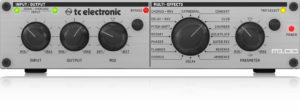
Sure, you have some great plug-ins for your DAW Definition:
Definition:
(Digital Audio Workstation): A computer program or stand-alone device that provides digital audio recording, editing, and mixing.. But then the singer wants to hear some reverb Definition: Short for Reverberation. The myriad echoes of decaying amplitude created in an acoustic environment. Reverberation may be simulated electronically, mechanically using springs or a metal plate, or in a specially built physical chamber with reflective surfaces where a speaker sends audio into the chamber, and a microphone picks up the reflections. in the headphones. Or the bass player needs to hear the effect
Definition: Short for Reverberation. The myriad echoes of decaying amplitude created in an acoustic environment. Reverberation may be simulated electronically, mechanically using springs or a metal plate, or in a specially built physical chamber with reflective surfaces where a speaker sends audio into the chamber, and a microphone picks up the reflections. in the headphones. Or the bass player needs to hear the effect Definition: A device or software program that modifies some aspect of audio or video. With audio, the term is used interchangeably with signal processor. of compression
Definition: A device or software program that modifies some aspect of audio or video. With audio, the term is used interchangeably with signal processor. of compression Definition: 1. Reducing the dynamic range of an audio or video signal for consistency, to keep it from exceeding the available headroom, or providing a special effect. 2. With data, using a process to reduce the amount of data. Compression can be lossless, where decompressing replicates the original signal, or lossy, where compression occurs by judging some data as unnecessary, and can therefore be discarded from the file. while playing. Or the guitarist wants some chorusing
Definition: 1. Reducing the dynamic range of an audio or video signal for consistency, to keep it from exceeding the available headroom, or providing a special effect. 2. With data, using a process to reduce the amount of data. Compression can be lossless, where decompressing replicates the original signal, or lossy, where compression occurs by judging some data as unnecessary, and can therefore be discarded from the file. while playing. Or the guitarist wants some chorusing Definition: A signal processing technique that makes one instrument (or voice) sound like several instruments of the same type playing in ensemble. It does this by adding copies of the input signal with short delays, and then modulating the delay times. while overdubbing
Definition: A signal processing technique that makes one instrument (or voice) sound like several instruments of the same type playing in ensemble. It does this by adding copies of the input signal with short delays, and then modulating the delay times. while overdubbing Definition: Recording new sound to a blank track on a multitrack or another recorder, while listening to a previously recorded sound in order to synchronize the parts.… but as soon as you add plug-ins, you’re dealing with latency
Definition: Recording new sound to a blank track on a multitrack or another recorder, while listening to a previously recorded sound in order to synchronize the parts.… but as soon as you add plug-ins, you’re dealing with latency Definition:
Definition:
The amount of delay a signal, data, sound, video, or control signal acquires within a device, system, or long-distance connection. issues and unhappy musicians. The solution: insert a simple, inexpensive, fine-sounding hardware processor Definition: A device that modifies signals. In audio, this typically affect dynamics, frequency response, harmonics, or time. In video, processors typically affect color, intensity, and special effects. like TC Electronic’s M100 (Fig. 3) in the cue
Definition: A device that modifies signals. In audio, this typically affect dynamics, frequency response, harmonics, or time. In video, processors typically affect color, intensity, and special effects. like TC Electronic’s M100 (Fig. 3) in the cue Definition: 1. (verb) Monitoring and getting a program event ready to go, or direction to talent to commence a program or portion of a program. 2. (noun) A particular piece of music in a video, film, or TV score associated with a particular on-screen event. out to give players what they want. It’s stereo
Definition: 1. (verb) Monitoring and getting a program event ready to go, or direction to talent to commence a program or portion of a program. 2. (noun) A particular piece of music in a video, film, or TV score associated with a particular on-screen event. out to give players what they want. It’s stereo Definition: A two channel signal simulating a sound space, typically played through two speakers., with 16 presets that cover reverb, delay
Definition: A two channel signal simulating a sound space, typically played through two speakers., with 16 presets that cover reverb, delay Definition: A device that outputs and input signal some time later. This can be short for echo effects, longer for matching speaker stacks, or aligning sound and video., chorus, flanging
Definition: A device that outputs and input signal some time later. This can be short for echo effects, longer for matching speaker stacks, or aligning sound and video., chorus, flanging Definition: A swooshing audio effect caused by mixing together two identical signals, with one slightly delayed and modulated to create continuously varying time differences. The technique originally used two tape recorders recording and playing back, with the engineer holding back one of the supply reel flanges, or using variable speed controls, to alter one tape recorder's speed compared to the other., phaser
Definition: A swooshing audio effect caused by mixing together two identical signals, with one slightly delayed and modulated to create continuously varying time differences. The technique originally used two tape recorders recording and playing back, with the engineer holding back one of the supply reel flanges, or using variable speed controls, to alter one tape recorder's speed compared to the other., phaser Definition: An audio effect that splits a signal into two paths, varies the signal phase on one path, then combines the two paths back together. This creates comb filtering effects. See also: Phase or Comb Filter., rotary speaker, pitch shifter
Definition: An audio effect that splits a signal into two paths, varies the signal phase on one path, then combines the two paths back together. This creates comb filtering effects. See also: Phase or Comb Filter., rotary speaker, pitch shifter Definition: A signal processing device or software routine that raises or lowers pitch. See: Pitch., and several multi-effects. At this price, it’s tough to beat.
Definition: A signal processing device or software routine that raises or lowers pitch. See: Pitch., and several multi-effects. At this price, it’s tough to beat.
Give Me Your Hand

Back in 1979, AT&T said, “reach out and touch someone.” But in the studio, we want to reach out and touch a physical control. Unfortunately, control surfaces tend to be pricey—nor are they generally laptop-friendly, and they usually fight for space with the QWERTY keyboard you use with your DAW. But the USB-powered, Korg nanoKONTROL2 (Fig. 4) MIDI Definition: (Musical Instrument Digital Interface) A hardware/software standard for communication of musical data digitally among electronic instruments, effects, and computers. However it is also used for to control lighting, pyrotechnics, theatrical displays, and mechanical devices. For example, the fountains at the Bellagio in Las Vegas is controlled by MIDI. Also called MIDI 1.0. control surface
Definition: (Musical Instrument Digital Interface) A hardware/software standard for communication of musical data digitally among electronic instruments, effects, and computers. However it is also used for to control lighting, pyrotechnics, theatrical displays, and mechanical devices. For example, the fountains at the Bellagio in Las Vegas is controlled by MIDI. Also called MIDI 1.0. control surface Definition: A device that provides mechanical controls, such as switches, rotary controls, and faders to provide hands-on control of software parameters. A typical application is creating a box with faders to control the levels in a software mixer. is different. It can fit in front of or behind your keyboard and is a great complement to a laptop-based recording setup. The control set includes eight channels of faders, panpot
Definition: A device that provides mechanical controls, such as switches, rotary controls, and faders to provide hands-on control of software parameters. A typical application is creating a box with faders to control the levels in a software mixer. is different. It can fit in front of or behind your keyboard and is a great complement to a laptop-based recording setup. The control set includes eight channels of faders, panpot Definition: A mixer control for placing a signal in the stereo soundstage by varying the level going to the left, optionally center, and right channels. See also: Dual Panpot., buttons for solo/mute/record, and transport
Definition: A mixer control for placing a signal in the stereo soundstage by varying the level going to the left, optionally center, and right channels. See also: Dual Panpot., buttons for solo/mute/record, and transport Definition:
Definition:
1. A tape recorder mechanism that moves tape. 2. DAW control simulating a tape recorder's mechanical transport. controls. It’s freakin’ convenient, as well as cute, and can really help workflow in the studio—especially if you’re tight for space.
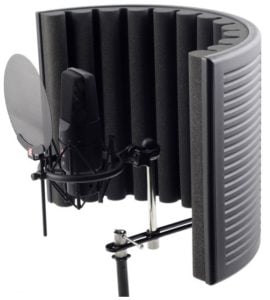
Take a (Mic) Stand for Better Vocals
Often the biggest problem in a vocal recording is the room itself, so the sE Electronics RF-X (Fig. 5) was designed to create what’s essentially a mini vocal booth Definition: A small, acoustically isolated room for recording or practicing voice narration or singing.. It helps absorb your voice, which keeps it from going out into the room, and also prevents reflections from getting into the mic. When set up properly, it can also provide some isolation from computer noise (like hard drives and fans). You do need to position the mic carefully; too far into the filter
Definition: A small, acoustically isolated room for recording or practicing voice narration or singing.. It helps absorb your voice, which keeps it from going out into the room, and also prevents reflections from getting into the mic. When set up properly, it can also provide some isolation from computer noise (like hard drives and fans). You do need to position the mic carefully; too far into the filter Definition: 1. (audio) A circuit that reduces certain frequencies, e.g., a low-pass or high-pass filter for audio. See also: Equalizer. 2. (optics) reduces certain color wavelengths or polarizations. alters the tone, and too far away diminishes its effectiveness—the placement shown in the image (and no, the mic is not included) is about right for most mics. The RF-X won’t necessarily take the place of a vocal booth, but fortunately, where it works the best is with rooms that need it the most. That’s pretty convenient!
Definition: 1. (audio) A circuit that reduces certain frequencies, e.g., a low-pass or high-pass filter for audio. See also: Equalizer. 2. (optics) reduces certain color wavelengths or polarizations. alters the tone, and too far away diminishes its effectiveness—the placement shown in the image (and no, the mic is not included) is about right for most mics. The RF-X won’t necessarily take the place of a vocal booth, but fortunately, where it works the best is with rooms that need it the most. That’s pretty convenient!



